Going behind the scenes of a prestigious, world-famous theatre is an eye-opening experience. On an organised visit to Covent Garden’s Royal Opera House we were met in the foyer by our guide, David, a very knowledgeable man who, in between singing on the West End Stage and working with orchestras at the BBC, has been a guide at the ROH most of his adult life. He was an excellent escort, obviously steeped in the history of the dancers and divas who had come and gone.

The Royal Opera House, Covent Garden, London - A Guided Tour
A tour around the Royal Opera House in London's Covent Garden gives a fascinating glimpse into a hidden theatrical world.
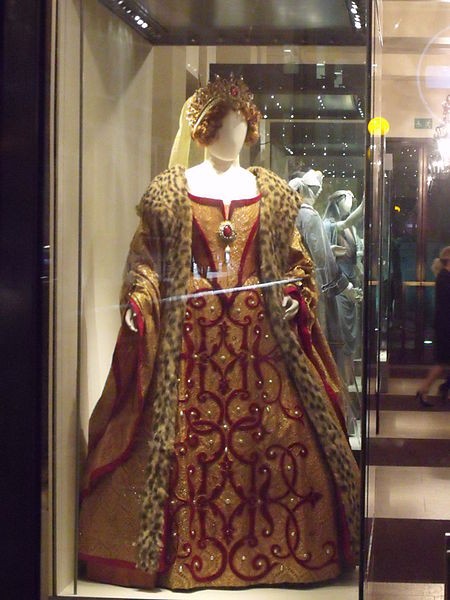 Elizabethan costume, Royal Opera House |
Our first stop, after an intriguing journey through various corridors, was a visit to one of the workshops where the costumes are designed and constructed. These rooms are light and airy with benches for sewing machines and large tables for cutting out patterns. It was thrilling to see the costumes, some partly made up, others completed, hanging up on racks.
The Royal Opera House presents not only operas, of course, but ballets too. Each stage of the costume design for these two genres has its own story to tell.
Opera
Costumes are initially made in cheap calico and sometimes the opera singers wear the prototypes whilst rehearsing to get the feeling of characterisation for the role. Larger singers will often have the sides of the costume darker to make them look slimmer! The world-famous opera star, Maria Callas, had her empire line dresses made so that they were gathered under her bust to ensure she looked slender.
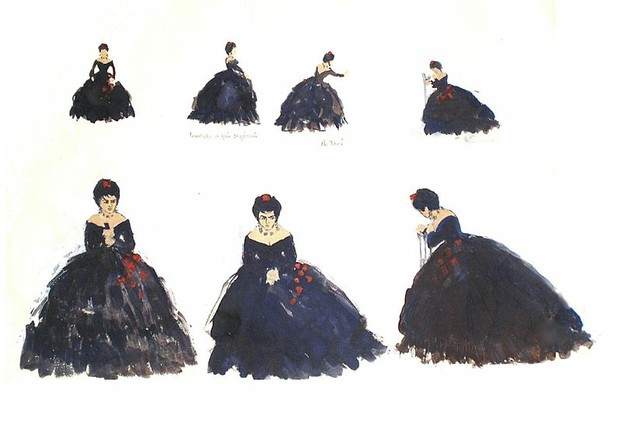 Paintings of soprano Virginia Zeani as Violetta in La Traviata Act ll scene 2 at the Royal Opera House Covent Garden Lo |
Designing and planning productions for any opera usually begins five years in advance because opera stars are booked up for long periods of time.
Such a lot of work goes into the production of an opera that when, as has been known to happen, a star says he or she is too ill to take on the assignment, there is panic and a desperate search for another who will, hopefully, fit into the costumes that have already been designed.
Films of Operas from the Royal Opera House
See the costumes close up!
 |  |  |
| Don Carlo: Live From the Royal Opera ... | Puccini: Tosca (Royal Opera House 2011) | Bizet: Carmen |
Ballet
The ballet dancer’s costumes are fitted with hooks and eyes instead of velcro or zips, which are both unreliable.
Also, there is only one set of costumes made for each production and these are often shared between dancers, so there are usually three sets of hooks and eyes on the costumes in order to accommodate any individual adjustments.
Lycra is used for some of the tighter costumes - it comes from Germany where apparently they make very good Lycra!
The costumes are shared with other opera houses as far away as America in order to save money.
Cleaning the embroidered, beaded and embellished costumes is very difficult and has to be done by experts. Sometimes in a production a beautiful costume is made - but then has to be dirtied and made to look worn if the part requires it. This is a sad day for the designer!
Female dancers have changed their shape over the years and are now taller and heavier than they were in the nineteen fifties. Darcy Bussell, the renowned ballerina, is 5'8" which would have been unacceptable a few years ago.
Films of The Royal Ballet from The Royal Opera House
The costumes designs are wonderful!
 |  |  |
| Tchaikovsky: The Nutcracker - featuri... | The Royal Ballet: Tchaikovsky- The Sl... | Delibes: Sylvia |
Outside in the corridors, on the same floor where the costumes are made, you can see original costumes in display boxes, and many framed original drawings used in their designs, as well as photographs of the dancers who wore the costumes.
The Royal Opera House Stage
A miracle of modern technology!
We then went above the back of the stage where we could look down onto the complicated machinery that goes into making a production.
(Apologies for this out-of-focus photograph but I was being jostled by other enthusiastic picture-takers! )
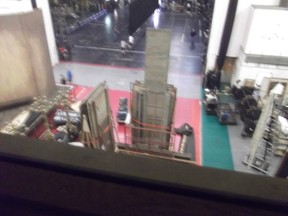 Part of the stage is painted red and this is moved when necessary to get the scenery into position. This red stage must rarely be walked on when it is at the back of the stage, and definitely not when it is moving away onto the stage itself. Hence the red paint. Once this red part is in place on the stage a covering ensures it is the same colour as the rest of the stage.
Part of the stage is painted red and this is moved when necessary to get the scenery into position. This red stage must rarely be walked on when it is at the back of the stage, and definitely not when it is moving away onto the stage itself. Hence the red paint. Once this red part is in place on the stage a covering ensures it is the same colour as the rest of the stage.
The technical side of the stage scenery movement is very complicated and has been designed by Rolls Royce. Two engineers from Rolls Royce are always on site to deal with any breakdowns that might occur.
Further along we looked through a glass window onto the largest lift in Europe. Lorries carrying scenery can come out of the street at the back of the Opera House and drive straight into the lift so that their load can be delivered to whichever level it is needed.
When the ballet goes on tour the sprung floor of the Opera House stage is taken apart and goes with them.
Watching Live Rehearsals
David took us along a lush, carpeted corridor lined with photographs of stars past and present. Suddenly he opened a door and we were in the beautiful auditorium.
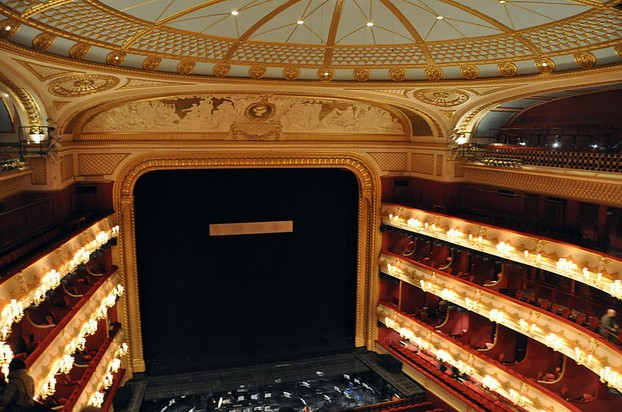 Auditorium, Royal Opera House, Covent Garden |
Something is going on every day - for instance when I was there, a group of children was working with a pianist and a soloist, all singing their hearts out! They were rehearsing for a future production.
We also watched a ballet being choreographed in one of the rehearsal rooms. We were separated by soundproofed, one-way glass so that we didn’t disturb the dancers and the pianist. This was a wonderful insight into the hard work and sheer sweat that goes into making the public performances look so effortless.
You never know what might be happening when you visit, but you will be taken in to view the auditorium and through the rehearsal rooms. If a rehearsal is taking place, then that’s a bonus.
Because of the variety of events taking place at the Royal Opera House on a daily basis, every guided tour is a unique experience.
The Royal Opera House, Covent Garden - Eating and Drinking
During the tour we passed through areas where people were having a relaxed coffee and snacks. We also glimpsed the staff preparing the tables in the more glamorous restaurants.
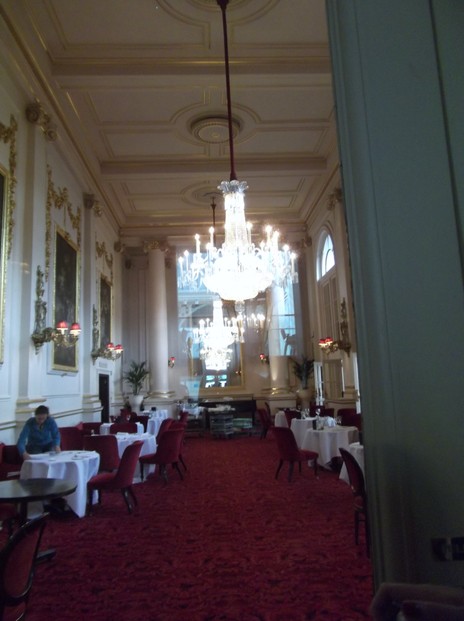 A Restaurant, Royal Opera House K Duffy |
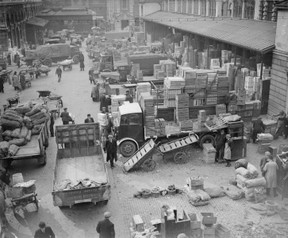 The part where the Champagne Bar now is was once the world-famous fruit and vegetable market of Covent Garden. I remember it from when I was young and coming out of jazz clubs in the early hours.
The part where the Champagne Bar now is was once the world-famous fruit and vegetable market of Covent Garden. I remember it from when I was young and coming out of jazz clubs in the early hours.
The porters would be hard at work or drinking tea and smoking in the old cafes which never closed.
Now it is part of the Royal Opera House - a beautiful space crowned with the original gorgeous glass roof. A different life, true. But beautiful, nevertheless.
This Champagne Bar is where all the stars from the BAFTA (British Academy of Film & Television Arts) awards come to either celebrate or to drown their sorrows.
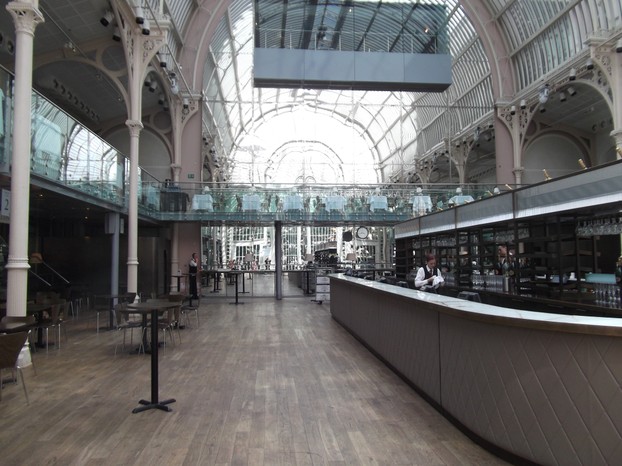 Champagne Bar, Royal Opera House K Duffy |
At the Royal Opera House the various cafes, the Champagne Bar and the restaurants are all open to the public, including their fabulous roof top terrace with views over London.
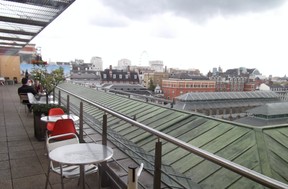
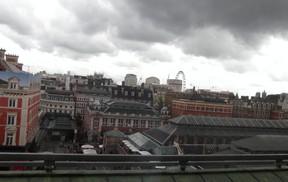
If you're ever around Covent Garden during the day, why not pop into the Royal Opera House for a cup of coffee! It really is a lovely thing to do, especially if you are touring central London, shopping or meeting up with friends. And it's not expensive.
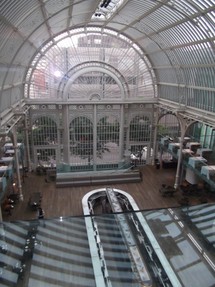 You can gaze down onto the Champagne Bar or, if the weather's nice, sit outside and admire the view. Then you can take the escalator down to the ground floor and leave the magical world of the theatre to continue your visit to Covent Garden.
You can gaze down onto the Champagne Bar or, if the weather's nice, sit outside and admire the view. Then you can take the escalator down to the ground floor and leave the magical world of the theatre to continue your visit to Covent Garden.
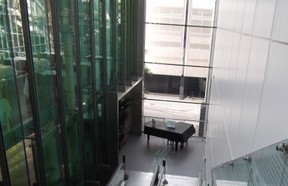
Royal Opera House Tour Highly Recommended
I went to the Royal Opera House with an organised group, but it is possible to go independently. The Royal Opera House website has all the information you will need to take a tour.
It is also possible to visit their massive studios in Purfleet where they make all the stage sets and scenery for the various productions. Again, all the information you will need is on the website.`
It was a fabulous experience going behind the scenes. The history of ballet and opera seems to seep out from the walls.
Once you've been, you will really appreciate how, in order to function smoothly, the Royal Opera House, Covent Garden, depends on the superb talents, organising abilities and dedication of a vast crew of people from all walks of life.
It really is Team Work!
Royal Opera House Items
Order from E-Bay
You might also like
A Guided Tour of The Theatre Royal Haymarket, LondonA tour of the Theatre Royal Haymarket, just a short walk from London’s Piccad...
When the Ballet Russes Came to EnglandSergei Diaghilev’s great Russian ballet company, Ballet Russes, performed i...
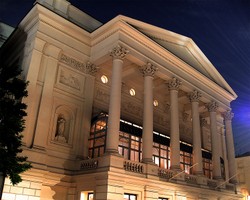


 How to Choose a Walking Cane or Stickon 08/01/2014
How to Choose a Walking Cane or Stickon 08/01/2014
 Michael Miller Fabulous Fabric Swatches for Quilting, Crafts etcon 07/02/2014
Michael Miller Fabulous Fabric Swatches for Quilting, Crafts etcon 07/02/2014
 The Drama of Life in the Rock Poolon 06/08/2014
The Drama of Life in the Rock Poolon 06/08/2014
 The Flâneur - Symbol of Modernity in 19th Century Parison 05/09/2014
The Flâneur - Symbol of Modernity in 19th Century Parison 05/09/2014

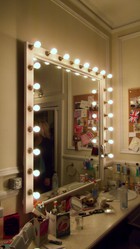
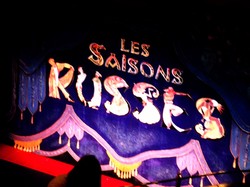
Comments